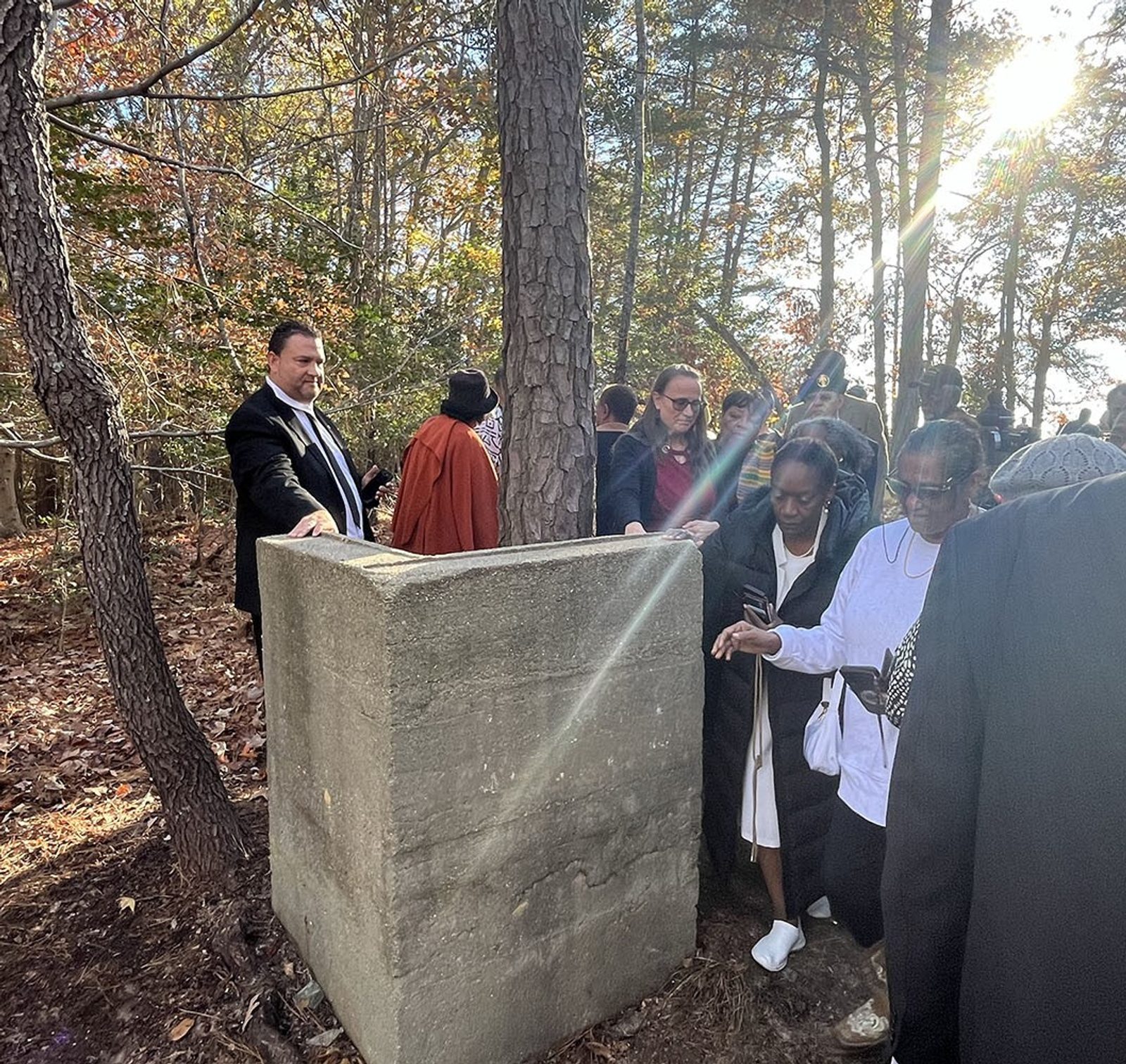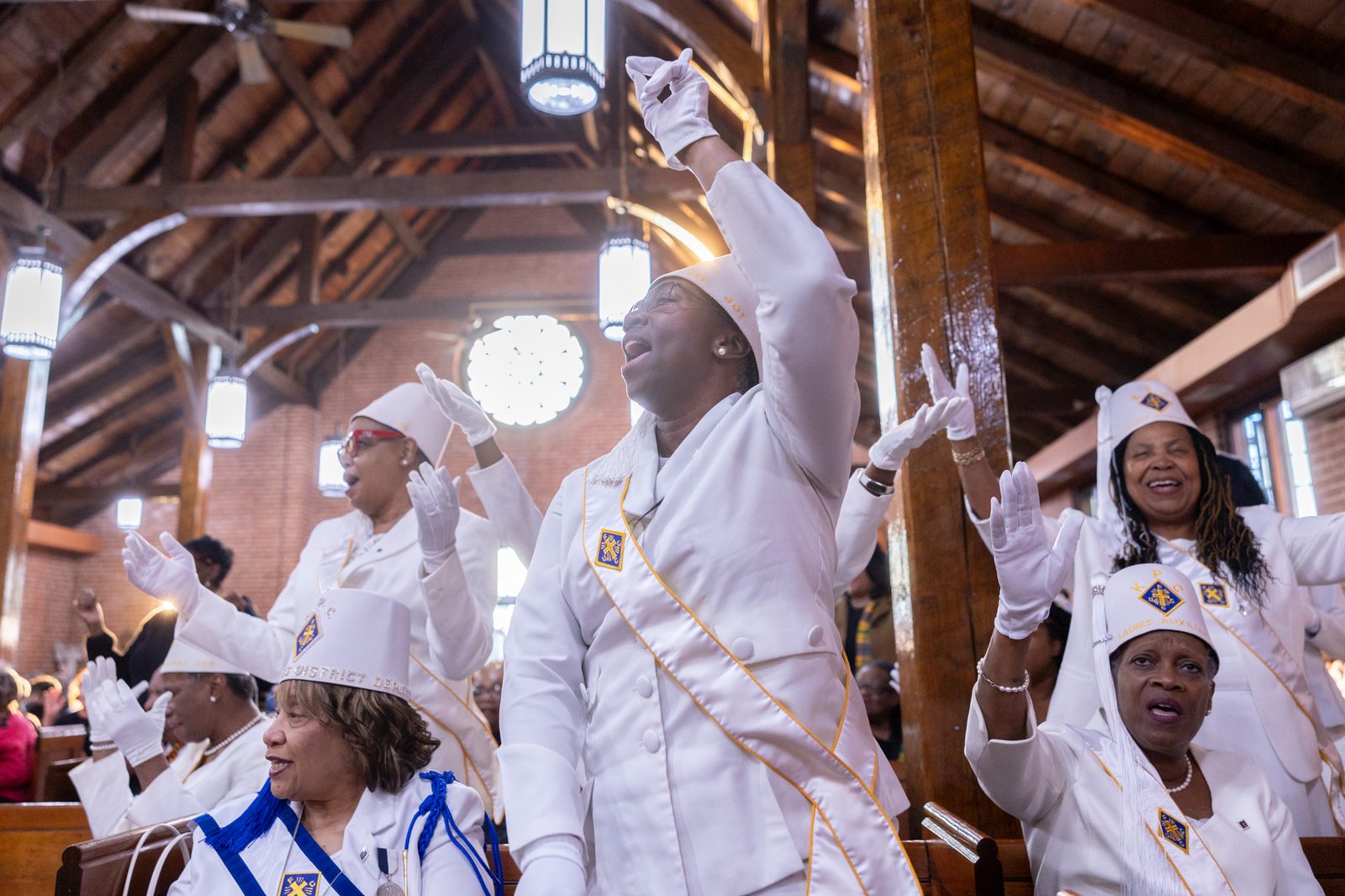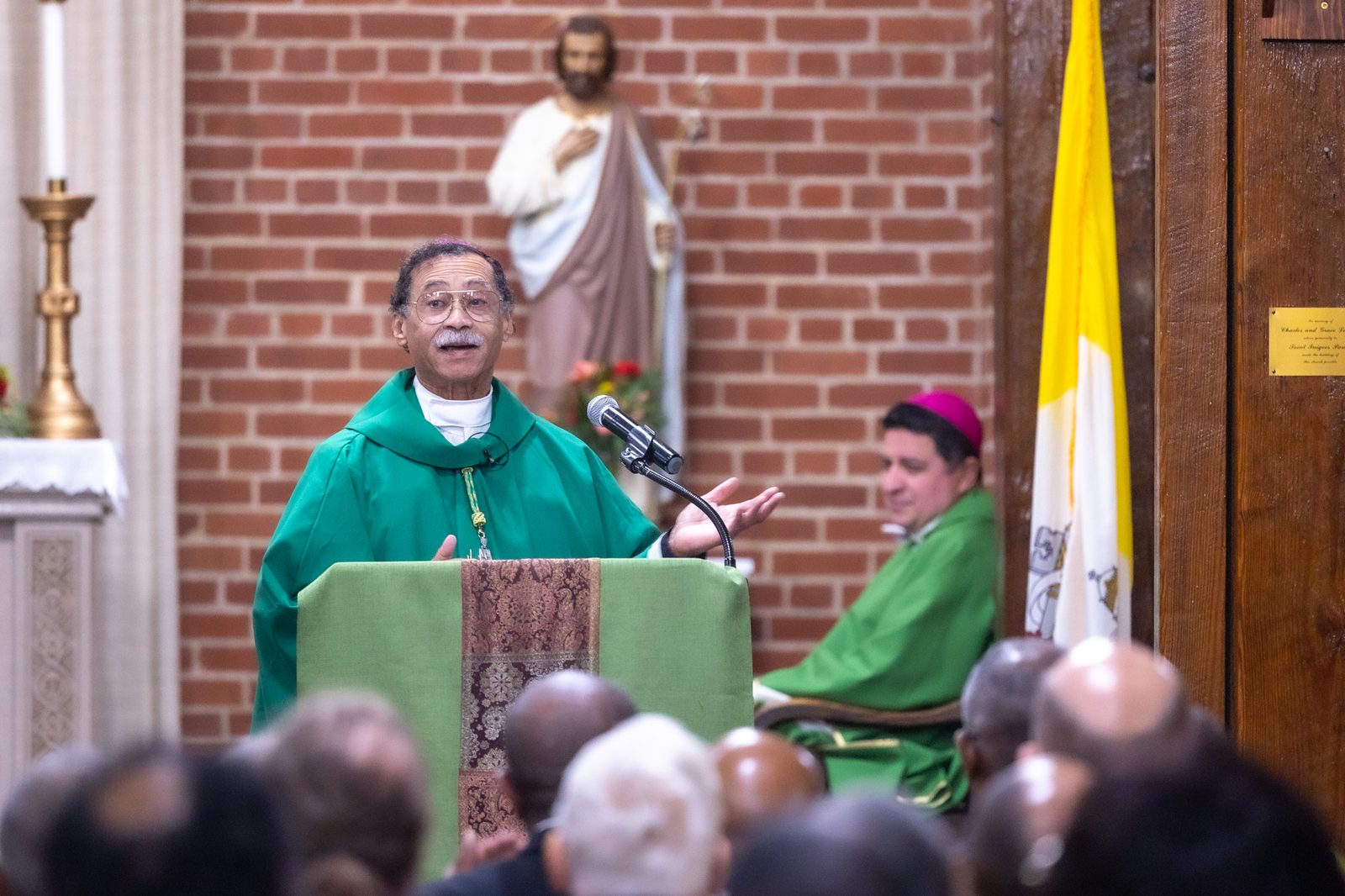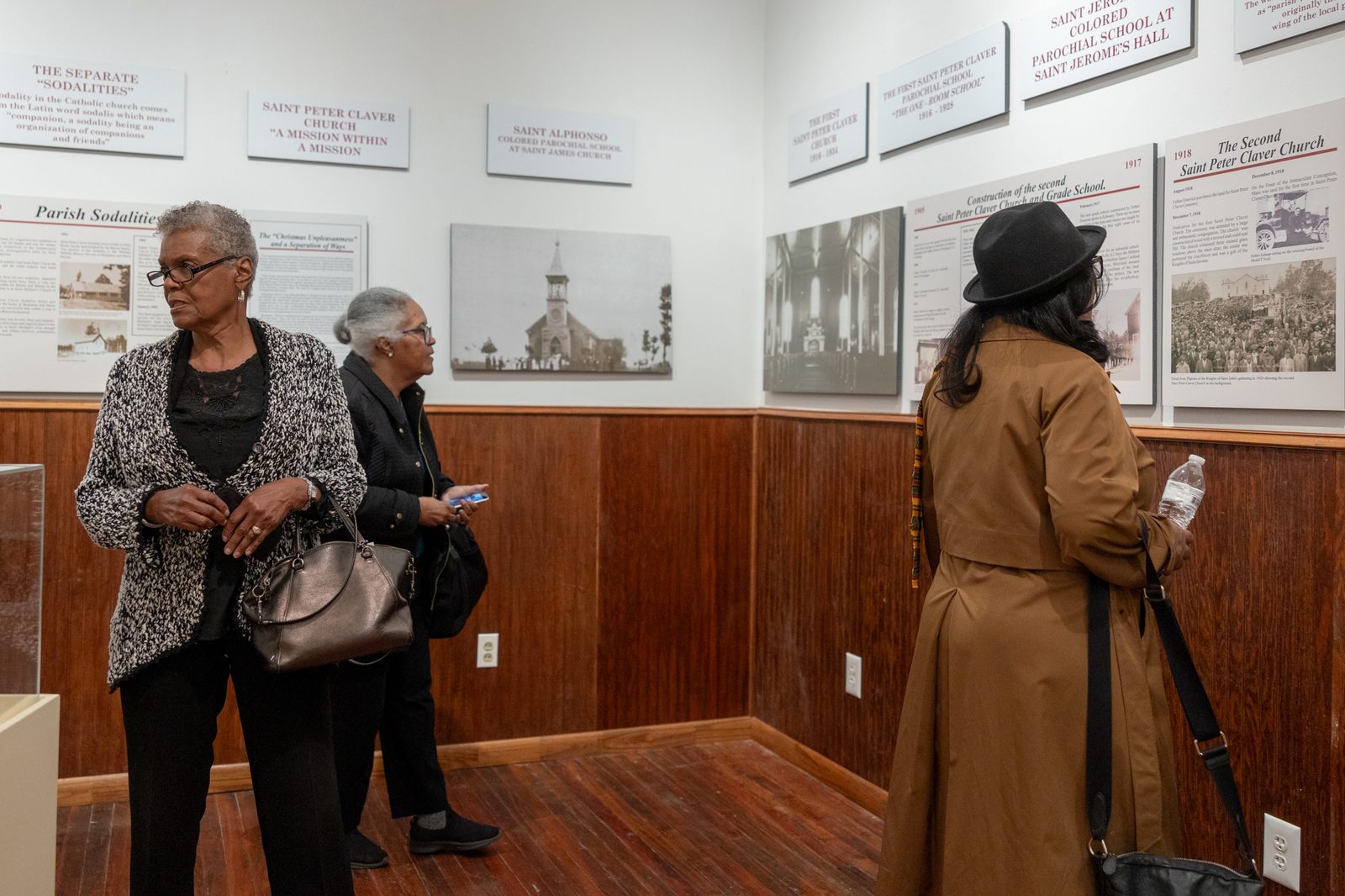When the St. Peter Claver Gospel Choir sang the spiritual, “We Have Come This Far by Faith,” those words rang true for the 250 people filling that parish’s small brick church in St. Inigoes, Maryland, for a Mass on Nov. 16, 2024 to commemorate Black Catholic History Month. The Vigil Mass was part of a pilgrimage to Black Catholic roots in Southern Maryland sponsored by the Office of Cultural Diversity and Outreach of The Roman Catholic Archdiocese of Washington.
Pilgrims had come from across the archdiocese, including on a bus from Washington, D.C., carrying members of the Sisters of the Spirit group of African American Catholic women, and on a bus from St. Joseph Parish in Largo in Prince George’s County, Maryland. They had come to learn about and honor the legacy of Black Catholics at that St. Mary’s County parish who from colonial times to the digital age kept the faith through eras of enslavement, segregation and racism in society and the Church.
That afternoon St. Peter Claver Church, Father Patrick Agustin – the administrator of that parish and of nearby St. Cecilia’s Parish in St. Mary’s City – welcomed the pilgrims, saying, “We have a story to tell. It’s not just our story. It’s your story as well. It’s the Church’s story.”

Then Washington Auxiliary Bishop Roy Campbell Jr. – who was later the main celebrant for the Black History Month Mass there – noted they had come to examine the roots of Catholic history there, and the role that Black Catholics played in it.
“It’s our history that we make every day. It’s because of those who came before us that we practice the faith in our hearts and in our lives… They never gave up the faith. They always lived, sung and worshiped the God that they knew could set them free,” Bishop Campbell said.
St. Peter Claver Parish is named for the 17th century Spanish Jesuit priest know for his missionary work evangelizing thousands of enslaved Africans in South America, and a portrait of that saint hangs on a wall near the church’s altar.
Wendi Williams, the executive director of the archdiocese’s Office of Cultural Diversity and Outreach, led the group in a special prayer for the day, and she noted how that summer, a Maryland State Historic Marker commemorating the history of the St. Peter Claver complex had been blessed and dedicated nearby, down the road from the church at the corner of St. Peter Claver Church Road and Point Lookout Road.
Also greeting the pilgrims was Dr. Francine Hawkins, a longtime member of St. Peter Claver Parish, who noted that they would be taking a walking pilgrimage of six historic sites on the parish grounds, so they could “grab the gifts of your roots in Southern Maryland to bring them forward to build upon them.”
At the first pilgrimage stop inside St. Peter Claver Church, parishioner Steve Hawkins traced the history of Catholicism in Maryland, noting how on March 25, 1634, Jesuit Father Andrew White celebrated the first Mass in the English-speaking colonies at St. Clement’s Island in what is now Southern Maryland. Those first English colonists arriving on the ships the Ark and the Dove included Mathias de Sousa, the first Black Marylander. He was an indentured servant of African and Portuguese descent who later became a mariner and fur trader.
In 1636, the Jesuits purchased land that became their St. Inigoes mission and plantation in the Southern Maryland region where St. Peter Claver Parish is located. From colonial times through the mid-1800s, the Jesuits’ ministry and missionary work were supported by their Maryland plantations farmed by enslaved people, indentured servants and other workers. The Jesuits baptized and taught the Catholic faith to the enslaved workers and their families at those plantations. Some families at the St. Inigoes plantation were torn apart by the Maryland Jesuits’ infamous 1838 sale of 272 enslaved men, women and children to Louisiana sugarcane plantation owners that helped ensure the financial survival of the Jesuits’ Georgetown College in Washington, D.C.
At the second pilgrimage stop at the site of the former St. Peter Claver Sodality Hall at a wooded area near the church, Claudette Bennett, the archivist for St. Peter Claver Parish and a lifelong parishioner there, noted how the hall was built for Black Catholics in 1901 on land donated by Benjamin Biscoe, who a nearby plaque notes was the donor of the original acre for what became St. Peter Claver Parish. At that time, Black Catholics had been worshiping at nearby St. Michael Church in Ridge, Maryland, but racist incidents at that church in 1902 at Christmas, including a white pianist who wiped off the keys after the Black Catholic choir sang there, caused a split among Catholics there.
In January 1903, the first Mass was celebrated at the St. Peter Claver Sodality Hall, which then became a makeshift church and began serving as the first structure in Southern Maryland where Masses were celebrated exclusively for Black Catholics. Over the years, the Sodality Hall also hosted classes and parish social events until it was torn down in the 1950s. Some of the pilgrims attending the Black Catholic History Month event walked down a path in the woods and touched the remnants of a wall of the former St. Peter Claver Sodality Hall where ancestors had once worshiped and attended parish events.

The third pilgrimage stop outside St. Peter Claver Church was led by parishioner Teri Wilson, who noted that the first church there was complete in 1918 and destroyed by fire in 1934. Then Philip Frohman, the architect of the National Cathedral in Washington, D.C., designed the current St. Peter Claver Church that was completed in 1938.

The fourth pilgrimage stop at the site of the former St. Peter Claver Elementary School was led by parishioner Sandra Johnson, who noted that the first St. Peter Claver School providing an education for the area’s Black children was a one-room schoolhouse for grades one through five that was built in 1917 and originally staffed by lay women in the community.
In 1924, the Oblate Sisters of Providence – the world’s first order of Black Catholic women religious – began staffing St. Peter Claver School. After a fire in 1928 destroyed the original school building, a new school was built there, and it was expanded to include grades six through eight. The Oblate Sisters continued serving there until the last elementary class graduated in 1966 and the school closed. Johnson noted how that school provided a first-class education to generations of Black students there, which paved the way for their academic and professional achievements as adults.
Dr. Francine Hawkins told the pilgrims that “I certainly credit St. Peter Claver Elementary School with my Ph.D.” She attended the school from the first through the sixth grades before it closed, and she later earned a doctorate in communication science and speech language pathology.
That St. Peter Claver School building, which now hosts parish social gatherings and a museum of historic artifacts and exhibits, was renamed McKenna Hall in honor of the late Jesuit Father Horace McKenna, who served at St. Peter Claver Parish from 1931 to 1953 and worked for racial justice in Southern Maryland before later moving to Washington, D.C., where he helped found many outreach programs for the poor, including the SOME (So Others Might Eat) soup kitchen.
Anne Leblans – who has also been active in preserving the parish’s archives and helping to establish its museum – welcomed participants to the fifth pilgrimage stop, located down the road at the site of the parish’s former Cardinal Gibbons Institute which is now a memorial park named for that historic secondary school that served African American students from that region and from across the country.
In 1924, Jesuit Father John LaFarge led an effort to open the Cardinal Gibbons Institute, which became the first high school built to educate Black students in Southern Maryland. Leblans noted that students there received an education that was equal to or superior to white students in the county, and the curriculum there was patterned after the Tuskegee Institute in Alabama and focused on the liberal arts and the literature, music and art of the Harlem Renaissance, while also offering an agricultural extension program. Later the Oblate Sisters of Providence taught at the high school, which closed in 1967 after Black students began attending integrated schools in the area.
Pilgrimage participants posed for a group photo at the Cardinal Gibbons Institute Memorial Park, before proceeding to the sixth and last pilgrimage stop, at the site of the former convent for the Oblate Sisters of Providence who taught at the elementary and high schools at the St. Peter Claver Parish complex. A large photo near the altar at St. Peter Claver Church depicts Venerable Mother Mary Elizabeth Lange, who founded the Oblate Sisters of Providence in Baltimore in 1829, and whose cause for canonization is currently under consideration.

Before the Black Catholic History Month Mass at St. Peter Claver Church, some of the pilgrims were interviewed about the parish’s historic legacy.
Joseph Johnson, a graduate of St. Peter Claver Elementary School and the Cardinal Gibbons Institute, attended Georgetown University, where he earned a degree in accounting. Johnson, who went on to work as a certified public accountant, noted that his parents were sharecroppers.
“I don’t know where I’d be if it hadn’t been for the Cardinal Gibbons Institute,” said Johnson, who said the teachers there encouraged Black Catholic students to excel. At Georgetown University, he attended daily Mass, and now as a senior citizen, he continues to attend daily Mass at St. Joseph Parish in Pomfret, Maryland.
Johnson, who joined other Knights of St. John in attending the pilgrimage, said the education he received at St. Peter Claver Parish “is absolutely a part of who I am. It was a beautiful experience. I’m nobody without St. Peter Claver School and the Cardinal Gibbons Institute.”
Cameron Humes participated in the pilgrimage with some fellow students and with staff members of the Sister Thea Bowman Catholic Student Center at Howard University in Washington, D.C. The Howard University senior, who is majoring in political science and minoring in environmental studies and English, is from Alabama. He said it was interesting to learn about the history of the Black Catholic experience in the northern United States.
“They stayed loyal to God, the Father, Son and Holy Spirit, even when the world treated them as second-class citizens,” Humes said.
Also attending the pilgrimage was Henrietta Pike, a member of Our Lady Help of Christians Parish in Waldorf, Maryland, who works as a nursing supervisor at United Medical Center in Washington.
“It’s like coming home,” she said, adding, “My ancestors were enslaved by the Jesuits at St. Inigoes, and we descended from there.”
Pike noted that her great-grandparents are buried at the St. Peter Claver Parish cemetery, and her great-great grandmother Louisa Mahoney, was among the 272 enslaved men, women and children in the 1838 sale, but she hid in the woods and stayed behind, thanks to a warning given by one of the Jesuit priests. Louisa Mahoney, who was born in 1812 at the St. Inigoes plantation, continued faithfully attending church with her family after emancipation and worked for many years as a domestic at the Jesuits’ residence before dying in 1909 at the age of 96.
Reflecting on her ancestors, Pike said, “They were people of faith. My whole family was very faithful because the Jesuits instilled in them to be people of faith.”
She was among the pilgrimage participants who walked in the woods to touch the remnant of the wall of the St. Peter Claver Sodality Hall, because she knew that her great-great grandmother Louisa Mahoney once attended Masses there. “It’s like walking the land where she walked,” Pike said.



Before the Vigil Mass for the Black Catholic History Month pilgrimage, the St. Peter Claver Gospel Choir sang praise and worship songs, including the spiritual “Blessed Assurance,” which includes the lyrics, “This is my story, this is my song, praising my Savior all the day long.”
People in the congregation stood and clapped as the choir sang the stirring hymn “Total Praise” by Richard Smallwood that includes the lyrics, “You are the source of my strength, you are the strength of my life. I lift my hands in total praise to you.”

In his homily at the Mass, Bishop Campbell emphasized that Jesus “calls us now to love one another, to give ourselves completely out of love and service to each other.”
Bishop Campbell – who also serves as the president of the National Black Catholic Congress and as the pastor of St. Joseph Parish in Largo – noted that of the six Black Catholics from the United States now being considered for sainthood, three of them were once enslaved.
Venerable Pierre Toussaint (1776-1853), known for his charitable work in New York City, had been born a slave in Haiti. Venerable Father Augustus Tolton (1854-1897), was a former slave who was baptized and raised Catholic and who became the first U.S. Roman Catholic priest publicly known to be Black. He was ordained in Rome in 1886 and served as a parish priest in Chicago. Servant of God Julia Greeley, who was born into slavery in Missouri between 1833 and 1848, later lived in Denver and converted to Catholicism and was known for her devout faith. She died in 1918.
The other three U.S. Black Catholics being considered for sainthood include Venerable Mother Mary Elizabeth Lange, who lived from 1784-1882; Venerable Henriette Delille (1813-1862), the foundress of the Sisters of the Holy Family in New Orleans; and Servant of God Sister Thea Bowman (1937-1990), a native of Mississippi who converted to Catholicism and became a member of the Franciscan Sisters of Perpetual Adoration and was nationally known as a dynamic evangelist and educator.
Bishop Campbell said each one of those Black Catholic leaders, known as the “Sacred Six,” lived lives of love and offer an example to today’s Catholics on how to live.
“In Black Catholic History Month, we celebrate those saints and those to-be-saints who have suffered, who have lived, who have loved, in spite of being persecuted because of the color of their skin in this country… What they are teaching us is that you and I are called to do the same,” he said.
The bishop encouraged people “to rely on the Lord, and He will give us all we need.”
“When we feel that there’s no hope, remember, He is our hope, and He will never leave us,” Bishop Campbell said, adding, “Whatever we are called to do in this life, Jesus will make sure we have whatever we need to do what He wants us to do.”
As he concluded his homily, the bishop told the pilgrims, “None of us travel the road alone. We’re walking together.”

After Communion, Wendi Williams and Karen Fowler of the archdiocese’s Office of Cultural Diversity and Outreach presented Father Agustin and St. Peter Claver Parish with artwork depicting the Sankofa bird, a symbol from the Twi language of Ghana that represents looking into one’s past in order to move forward. According to a prayer card from the Office of Cultural Diversity, “the symbol honors the cultural values from African history that can provide direction and strength to move forward.”

As the Mass ended, the St. Peter Claver Gospel Choir led the congregation in singing “Soon and Very Soon” by Andrae Crouch, and the pilgrims gathered for a reception at McKenna Hall and tours of the parish’s museum before heading home.












